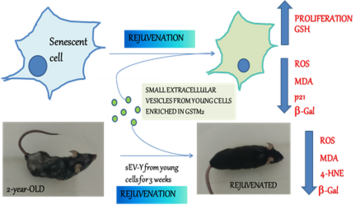Fafián-Labora JA, Rodríguez-Navarro JA, O'Loghlen A. Small Extracellular Vesicles Have GST Activity and Ameliorate Senescence-Related Tissue Damage.
Cell Metab. 2020
"Our data support the potential of sEVs as regenerative therapy in aging and age related diseases" - Dr. José Antonio Rodríguez Navarro -
Summary:
Aging is a process of cellular and tissue dysfunction characterized by different hallmarks, including cellular senescence. However, there is proof that certain features of aging and senescence can be ameliorated. Here, we provide evidence that small extracellular vesicles (sEVs) isolated from primary fibroblasts of young human donors ameliorate certain biomarkers of senescence in cells derived from old and Hutchinson-Gilford progeria syndrome donors. Importantly, sEVs from young cells ameliorate senescence in a variety of tissues in old mice. Mechanistically, we identified sEVs to have intrinsic glutathione-S-transferase activity partially due to the high levels of expression of the glutathione-related protein (GSTM2). Transfection of recombinant GSTM2 into sEVs derived from old fibroblasts restores their antioxidant capacity. sEVs increase the levels of reduced glutathione and decrease oxidative stress and lipid peroxidation both in vivo and in vitro. Altogether, our data provide an indication of the potential of sEVs as regenerative therapy in aging.
Why do you highligth this publication?
The ability to revert certain characteristics of aging in mice tissues could help in the treatment of age related diseases like neurodegenerative diseases, sarcopenia or some senescence related cancers.
Publication commented by:
Dr. José Antonio Rodríguez Navarro
Experimental Neurology Group
IRYCIS



